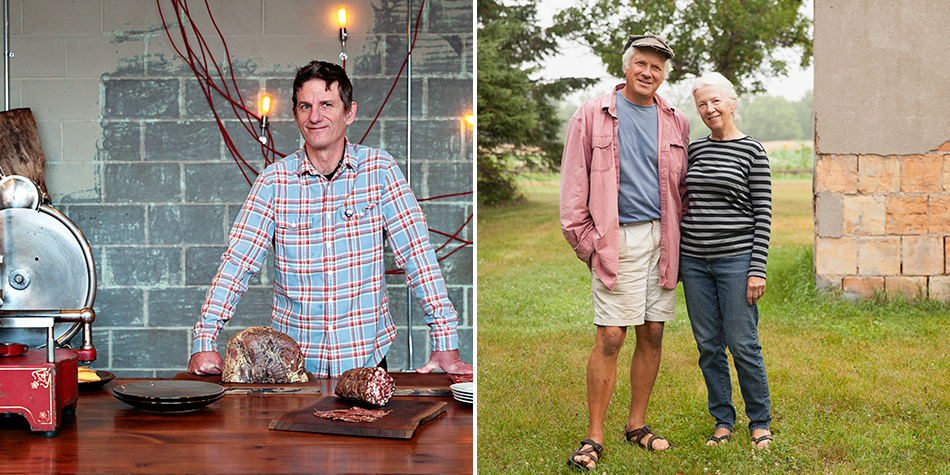Erik Sather shares his local sourcing do’s and don’ts
Located in the Food Building in Northeast Minneapolis, Lowry Hill Provisions sources heritage pork from regional farms for its hand-cut, hand-trimmed, hand-made salami. Combining carefully-sourced, quality ingredients with a lengthy fermentation process, the salami produced by Lowry Hill Provisions is wonderfully distinct and complex. Owner Erik Sather explains, “We embrace subtleties in our Old World style, especially with our hand-trimming, which takes extra gumption. Our products have a bouquet of flavors that complement each other really well. They please the palate, whether you want something aromatic or spicy or umami.”
Having honed his craft from mentors like salumiere Mike Phillips at Red Table Meats and butcher Kristen Tombers of Clancey’s, Erik learned the importance of sourcing local ingredients early on in his career. He comments, “Local ingredients represent your flavor and brand. If you’re going to make something, make it with the things around you. If you can find good pork from your neighbor, that’s who you should be buying from because that’s equitable economics. Use your close connections first, then get more and more regional as you grow.”
Everyone knows that sourcing locally involves a learning curve more complicated than receiving a single but impersonal shipment off a truck, and Erik has learned his fair share of local food sourcing lessons throughout the years. In the past, he sometimes found himself overbuying – because he wanted to do his part to support farmers – and then facing a hefty bill. It took time and practice to figure out how to buy the right quantity. He says, “Those were hard growing pains.” On the other end of the spectrum, he notes how as one’s business grows, finding consistent products from smaller farmers can be challenging, which is why he now needs to source regionally.
Erik’s sage advice for those new to local food sourcing? “Get your feet on the ground, go to a farmers’ market, and take it step by step, piece by piece.” He continues, “At the farmers’ market, find a farmer or an ingredient you really like and buy enough of something to use in a special dish or feature.” He explains how the relationship might start small with buying greens but then spill over into other ingredients once you experience some success. “You can manage one thing successfully,” Erik says, “so just grab onto an ingredient or a producer that you like and start there.”
He also believes in the power and importance of storytelling. He emphasizes, “Tell guests or customers why you’re preparing a certain product for them and who you sourced it from. You must share the story. That’s what builds loyalty and friendship that both small producers and customers alike want.”

How Riverbend Farm’s abundance inspired Salumiere Mike Phillips
Greg and Mary Reynolds own Riverbend Farm in Delano and are well known throughout Minnesota’s food and farming communities for their impeccable produce, reliability, and good-natured personalities. Chef and salumiere Mike Phillips, currently of Red Table Meat Co. has worked with farmer Greg for over twenty years, buying his produce, cooking at Riverbend Farm for special events, and sharing innumerable back and forth conversations together about each of their crafts.
Greg – and the trusted relationship they’ve built throughout the years – is the reason Mike created Red Table’s popular Boldog salami, only offered seasonally in the winter.
The story of the Boldog begins with Greg’s love of peppers and the abundance of paprika peppers he grew one year. A good growing season is certainly a gift, but Greg found himself sitting on nine hundred pounds of paprika peppers without a home, so he did what he often does: Greg began contacting some chef friends and educating them on the merits of his product.
Greg explains, “Paprika is a funny thing. If you buy a little jar of [your average] paprika, it’s mostly food coloring and pretty tasteless. But paprika made from fresh peppers that have been dried and freshly ground has the most delicious flavor – a combination of sweet and spice.”
Before purchasing, one chef wanted to do a taste test and compare it to his expensive Spanish paprika. He found that the Spanish paprika had a metallic aftertaste, whereas Greg’s didn’t. They wondered if the seeds had been ground along with the peppers. No matter the reason, he determined he preferred the taste of Greg’s paprika and bought the majority of the peppers from Greg, incorporating them into a gourmet goulash.
Mike Phillips was then lucky enough to get his hands on the last of the peppers, which became the impetus for the annual Boldog salami, a product inspired by the abundance of a nearby farm and that farmer’s knowledge.
Mike says, “It makes a difference to make something with all this connection and regionality.”

